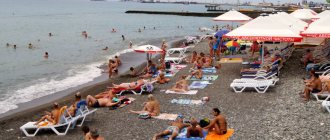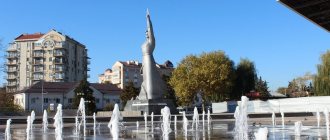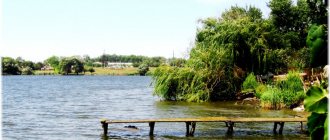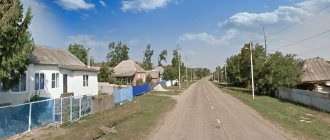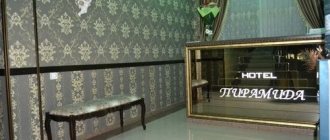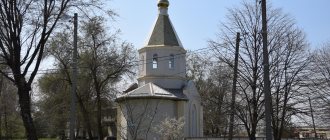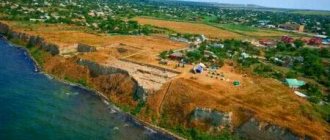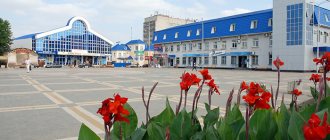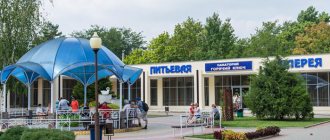Monument to the founders of Novorossiysk
Monument to the founders of Novorossiysk
Novorossiysk
The most famous monument in Novorossiysk is dedicated to the founders of the city. It is located on the shore of Tsemes Bay, on the Admiral Serebryakov embankment.
It was here that General Nikolai Raevsky and Vice Admiral Mikhail Lazarev landed in 1834. A few years earlier, the Turkish Tsemes Bay came into the possession of Russia, and the military leaders had to build a fort on the ruins of an old enemy fortress. The history of Novorossiysk began with him. And Rear Admiral Lazar Serebryakov in 1841 began to transform the military camp into a city. A school, a hospital and even a library appeared here.
The monument to the founders of the city was created by local sculptor Alexander Suvorov. Bronze figures of Raevsky, Lazarev and Serebryakov are installed on a granite pedestal. On the sides of the monument there are bronze plates with historical dates and cannons created according to models of the 19th century. The monument contains statements from Emperor Nicholas I and the hero of the War of 1812, Field Marshal Mikhail Vorontsov, the year the city was founded and the names of its founders.
Monument to the liberators of Novorossiysk
We will see one of the most famous monumental ensembles in the historical heart of the Central District of Novorossiysk - in the mini-square of Freedom Square. The latter is a fragment of the Pushkin Park, sandwiched by two lines of Sovetov Street. Visitors will need a rest stop. “Central Market”, through which half of Novorossiysk transport passes.
“Liberators” appeared in 1961 - these are three bronze figures, merging from afar into a common silhouette. The subject of the composition is a sailor, a soldier with a flag and a young female partisan. Each symbolizes a certain “kind” of fighters. The pedestal is made of diorite. There are bas-reliefs on it depicting the landing (the Liberation began with this event). The monument is the height of a 3-story building.
Ship of military glory "Mikhail Kutuzov"
Ship of military glory "Mikhail Kutuzov"
Novorossiysk
On the Admiral Serebryakov embankment you can also see the museum ship - the cruiser Mikhail Kutuzov. It was laid down in February 1951 at the Nikolaev Shipyard, and three years later it was launched.
"Mikhail Kutuzov" was part of the Black Sea Fleet. He served in the Mediterranean and Black Seas, in the central Atlantic, and also participated in two armed conflicts of the Arab-Israeli War - in 1967 and 1973. During all this time, the ship traveled 211,900 miles - that’s almost 400 thousand kilometers.
The ship left service in 1998, and in 2012, the ship of military glory “Mikhail Kutuzov” became a branch of the Central Naval Museum. Tours take place on the upper deck. Museum guests can see the ship's bell, cannons and mine armament of the ship. Also open to visitors are the ship's wardroom, the galley - the ship's kitchen, the first aid station, one of the combat posts and the sailor's quarters.
Other memorial objects of Novorossiysk about the war
- IL-2 and the square of the 75th anniversary of the Victory. A real plane shot down in 1943. The shell of the attack aircraft was discovered at the bottom of the Black Sea in 1974. The plane was raised, reconstructed and turned into a monument. Behind Il-2 there begins a pleasant alley for walking. Address: intersection of Heroev Paratroopers Street and Lenin Avenue, opposite the letters Malaya Zemlya.
- Memorial complex Death Valley. Another memorial dedicated to the defense of the bridgehead and the liberation of Novorossiysk. The complex includes several objects: the “Explosion” monument made of fragments of shells, mines and bombs; steles telling about the largest battles on Malaya Zemlya; anti-tank "hedgehog" on a pedestal. Even the tree growing here is also a monument: the plane tree was planted by Brezhnev in 1974. Address: Myskhako village. It is recommended to combine it with a visit to the Myskhako winery.
- Memorial "Line - Line of Defense". Another monumental monument, created by the author who created the ensemble “Malaya Zemlya”. It is located by the road and is a 40-meter reinforced concrete structure with four giant male hands. Next to them stands the monument “The Shot Car”. The place where the memorial was created is not accidental: in 1942, cement factory workers created homemade barricades here, including a railway carriage. The frame of the carriage, riddled with bullets, was installed in 1946, and the “Line – Line of Defense” memorial appeared in 1978. Address: M-4 Don, 1541st kilometer.
If you are short on time and want to see the military monuments of Novorossiysk, book the excursion “All Facets of Novorossiysk - by car in 3 hours.”
TOP 15 attractions of Novorossiysk
Route around Novorossiysk in 1 day
Abrau-Durso in one day
Novorossiysk Historical Museum-Reserve
Novorossiysk Historical Museum-Reserve
Novorossiysk
The Novorossiysk Historical Museum-Reserve is the oldest in the city; it was created in 1916 as a museum of nature and history of the Black Sea coast of the Caucasus. However, during the Great Patriotic War, he lost almost all of the exhibits. A new exhibition with a diorama triptych “Liberation of Novorossiysk from the Nazi invaders. 1943" was created only in 1960.
The museum-reserve houses archaeological finds from ancient settlements and burial grounds, a collection of anchors, the family fund of the writer Fyodor Gladkov and the photo archive of TASS correspondent Evgeniy Khaldei.
The complex includes permanent exhibitions that tell about the history and nature of the region, and the house-museum of the Soviet writer Nikolai Ostrovsky: the building and interiors were restored using old documents and photographs. The Historical Museum-Reserve also owns an exhibition hall and the “Malaya Zemlya” memorial.
Monument "The Unconquered"
The facility is located on the ninth kilometer of the Anapa highway, in the Tsemdolina residential area. This section of the route is a street with an amazing name - Zolotaya Rybka. The nearest public transport stop is called “Selkhoztekhnika” (No. 8, 8A). Landmarks are the wholesale base of the same name and two Rosneft gas stations.
And this work is dedicated to the civilian population - the townspeople who died in fascist captivity in 1942-1943. The 1963 monument consists of a 20-meter white obelisk - a thinning octagon.
In front of him is a sculptural group made of bronze: a woman clutching a boy in a torn shirt to her chest, and an old man with his head held high. The composition symbolizes the spirit of freedom of the Soviet people. Part of the tortured and then executed population of the city is buried here (in total, more than 7,000 people died in this way).
Memorial "Malaya Zemlya"
Memorial "Malaya Zemlya"
Novorossiysk
The “Malaya Zemlya” memorial is located in the area of Cape Myskhako, seven kilometers from Novorossiysk. It consists of a museum of military glory and a museum of military equipment. “Malaya Zemlya” was erected in memory of Soviet soldiers who fought for the city during the Great Patriotic War.
On the night of February 4, 1943, paratroopers led by Major Caesar Kunikov broke through enemy fire, landed on the shore and captured a bridgehead, called “Malaya Zemlya.” Its defense lasted 225 days. From here began the key assault on the positions of the Nazi invaders, thanks to which Novorossiysk was liberated.
The monument was created by Soviet architects Vladimir Khavin, Yakov Belopolsky, Roman Kananin and sculptor Vladimir Tsigal. It was installed on the shore of Tsemes Bay made of granite and bronze. The memorial resembles the bow of a landing ship that rushed ashore. The bas-relief on the right side depicts the faces of soldiers ready to run into the attack; on the left is a sculpture of a sailor, an infantryman, a commander and a female medical instructor, as if frozen a second before the battle.
Around the monument you can still see traces of battles: grass-covered trenches, ditches and trenches. Nearby there is a museum of military equipment and weapons from the Great Patriotic War and a stele with a commemorative inscription. Inside the monument there is a gallery of military glory with a bronze capsule “Heart”. Around it are the names of the soldiers and sailors who fought on the Malaya Zemlya bridgehead.
Monument "Line of Defense"
We are talking about the main brand of the Eastern Municipal District. It is located right on the Sukhumi highway (M-4 highway) - on the site adjacent to the cement entrance. Nearby are the “Shooted Car” and the “Destroyed Cement Workers’ Palace of Culture”. Get off at bus stop No. 11 and No. 646 "October".
“Rubezh” was built in 1978. The 40 m long stele from a distance resembles a barrier thrown across the highway. Hands clutching PPSh machine guns are clearly visible on the stone surface. The names of military units taking part in the assault on Novorossiysk are carved on memorial plaques.
City Center of National Cultures
City Center of National Cultures of Novorossiysk
Novorossiysk
The city center of national cultures is located in a building built in 1908. In 1953, it was transferred to the construction Trust-12 for a cultural institution.
Since 1999, the city's center of national cultures has been located here. It includes national and cultural public organizations that represent different ethnic groups: Russian, Ukrainian, Georgian, German, Greek, Czech, Armenian, Tatar, Gypsy, Jewish, Dagestan. Every year they participate in the festival of national cultures “Novorossiyans” - in the best vocal and choreographic numbers they talk about the identity and traditions of their people.
"Monuments of the hero city of Novorossiysk"| The military valor of the Black Sea warriors. Monument to the Unknown Sailor Click to view in large format. |
On the Heroes' Square
a memorial complex was built.
Closer to the embankment there is an obelisk built in 1940 in honor of the 20th anniversary of the liberation of Novorossiysk from the White Guards and interventionists. A little further from the shore there are two marble monuments to the famous heroes of the battle for the city, Ts. L. Kunikov and N. I. Sipyagin. Participants in the battles for Novorossiysk in September 1943 are also buried here - Heroes of the Soviet Union S. N. Kadanchik and A. I. Lezhenin, commanders, political workers and paratroopers A. A. Lunacharsky, P. I. Isaev, A. M. Tikhostup, A.D. Tsedrik and many others. Each of the names is inscribed in golden letters in the history of the Great Patriotic War, behind each of these names is a bright, unique image of people who gave the most precious thing - their lives in the name of saving the Motherland. On September 15, 1958, between the graves of Kunikov and Sipyagin, in commemoration of the mass heroism shown by Soviet soldiers, partisans and underground fighters in the battles for Novorossiysk, the fire of Eternal Glory was lit. In 1960, it was soundtracked by the solemn melody “Novorossiysk Chimes”, written by the outstanding Soviet composer D. D. Shostakovich. The composer's gift to the hero city - the original score, which became a hymn to the feat of Novorossiysk and its defenders, is carefully preserved in the city's local history museum. In 1974, Heroes Square was reconstructed. A memorial wall was erected with the inscription: “To the Sons of the Fatherland, whose ashes rest in the land of Novorossiysk
. Monuments to war heroes stand surrounded by blue spruce trees, lawns, and flowers. The ensemble of the square is complemented by a gallery of portraits of Heroes of the Soviet Union - participants in the battles for Novorossiysk.
| Torpedo boat Click to view in large format. |
Heroes Square is the center of military-patriotic education. Since May 9, 1975, Komsomol Pioneer Post No. 1 has been installed near the memorial wall. Dressed in the uniform of military sailors, young Novorossiysk residents stand guard of honor at the graves of fallen heroes. Solemn pioneer parades, rallies, rallies are held here, soldiers take the oath of allegiance to the Motherland. From here begins the annual torchlight procession of young patriots, dedicated to the amphibious landing on Malaya Zemlya. The authors of the memorial complex are architects G. Najarian, G. Mayornikov. In 1960, a monument to the “Unknown Sailor”
. On a high granite pedestal stood a 7-meter bronze figure of a sailor with a machine gun on his shoulder. The monument became a symbol of the courage of the Black Sea soldiers. The authors of the monument are sculptor O. Kolomeytsev, architects E. Lashuk, K. Mikhailov.
| “Unconquered” Click to view in large format. |
In memory of the heroic exploits of paratroopers in 1968, a torpedo boat
.
The monument became a symbol of all the boats that took part in the battles for Novorossiysk in September 1943. The author of the monument is the architect N. Nikitin. Not far from the Novorossiysk-Krasnodar highway, a 20-meter octagonal reinforced concrete stele was installed - a monument to the “Unconquered”
.
At the base of the monument there is a bronze sculptural group - an old man and a woman with a child. Under the sculpture there is an inscription: “To the unconquered, tortured and shot here in 1943 by the fascist occupiers of Novorossiysk and the paratroopers of the Soviet Army.
Eternal glory to those who fell for the freedom and independence of our beloved Motherland . The authors of the monument are sculptor I. Shmagun, architects E. Lashuk, K. Mikhailov. Nowadays, a memorial complex “To the Heroes of the Civil War and the Great Patriotic War of 1941-1945” has been built in Novorossiysk. The basis of this grandiose work of art is made up of three compositional units: “Small Land”, “Defense Line” and “To the Sailors of the Revolution”.
| Monument-ensemble “Defense Line” Click to view in large format. |
In September 1978, on the eve of the 35th anniversary of the defeat of the Nazi troops in Novorossiysk, the monument-ensemble “Defense Line”
memorial complex. The monument was built in the area of Cement and “October”, where the fascist hordes rushing to the Caucasus were stopped. A huge beam-stele rose high. There are four powerful fists on it, squeezing machine guns. At the monument, on a pedestal, there is the skeleton of a railway carriage, riddled with bullets. The authors of the monument-ensemble are sculptor V. Tsigal, architects Y. Belopolsky, R. Kananin, V. Khavin.
Greek Colony of Bata
Based on ancient written sources and mentions of the first Russian settlers of Novorossiysk about the ruins of a certain ancient Greek city, scientists believe that in the 6th century BC. on the site of today's Novorossiysk there was the Greek city of Bata.
Once upon a time, on the site of Novorossiysk there was the Greek city-state of Bata
Archaeological evidence of its existence was found in later times during construction work during the Soviet period at the bottom of Tsemes Bay, etc.
Bata, like all Greek metropolises of that period, was a trading city-colony. The local colonists had well-developed agriculture, fishing, and various crafts. Trade was also going well. Mainly bread and fishery products were exported, while wines, olive oil, and ceramics were imported.
Bata was one of the easternmost Greek colonies
In the 5th century BC. Almost all the Greek city-states of the Black Sea region were united into a single Bosporan kingdom, which later became part of the Roman Empire. Bata found itself on the very southeastern border of this state entity.
The remains of this semi-mythical city have not been found and there is no direct evidence of its location. But it is believed that it was located on the site of the Seaport, whose structures concreted the possible remains of a Greek settlement. But the fact that there was an ancient Greek trading pier in Tsemes Bay is clear from the ancient anchors and amphorae found in the bay.
All ancient artifacts can be seen today in the Novorossiysk Museum
Fortified fortresses were built around Bath, which were supposed to secure the approaches to ancient Gorgippia (today's Anapa). One of these fortresses was located on the site of the village of Myskhako. All these Greek settlements were subsequently destroyed by the nomadic tribes of the Alans, Goths and Huns in the 2nd and 3rd centuries. Since then, the settlement of this region began by the ancestors of the Adyghe and Circassian peoples, who gave the name to the local river - Tsemez (translated as “swampy forest”). And the river, in turn, gave the name to the bay itself - Tsemezskaya.
Novorossiysk within Russia
First birth of Novorossiysk
So, in 1829
The Black Sea region officially became Russian territory. Since 1831, Russian warships cruised along the coast. Their task was to prevent smuggling trade between the highlanders and the Turks. And a little later, fortified outposts began to be created here. The first fortification of Tsemes Bay on Cape Doob was Kabardinka, which then, back in July 1836, was called the Alexandria fortification.
Count M.S. Vorontsov advocated the need to create a fortification in Tsemes Bay
The governor of this region, M.S. Vorontsov, wrote to the emperor about the need for a more powerful fortification of this bay. In the fall of 1937, Nicholas the First himself visited the new Russian shores, examining the already existing fortifications in the form of Gelendzhik and Anapa. At the same time, a decision was made on a military naval expedition to more remote areas of the Krasnodar coast with the aim of landing troops there and organizing new fortifications. This is how the now famous resorts Adler, Sochi, Lazarevskoye and many others appeared.
Nicholas the First came with his heir to get acquainted with the new Russian shores
The appearance of such a fortified point and port as Novorossiysk was the initiative and merit of General N. Raevsky. It was he who was able to prove the need to create a port city for Russian ships in Tsemes Bay. And already in January of the following year after the landing - in 1839
year, a new Russian settlement received the status of a city, which was called Novorossiysk. Within the 4-kilometer perimeter of the new city there were forts, blockhouses, ditches with drawbridges, and earthen ramparts. The civilian population settled in the lands outside the fortifications.
N. Raevsky is rightfully considered one of the main founders of Novorossiysk
At the end of the 40s, the Admiralty building grew up on the territory of the port fortress, built in the northwestern corner of the bay. The construction of this structure was approached very responsibly. Its project was developed by the Commander-in-Chief of the Black Sea Fleet M.P. Lazarev
, insisting that the structure be built of brick and sheathed with iron. Stone, brick and lime were brought from Kerch, and timber, iron and nails from Kherson. The construction of the Admiralty took 12 long years.
Today, on the site of the former Admiralty, there is the famous House with a Spire
The Admiralty, consisting of three one-story buildings connected to each other, housed an arsenal, food warehouses, a forge, premises for ship repairs, etc. Garrison employees were also involved in agriculture.
As already mentioned, General N. Raevsky
, considered the founder of Novorossiysk.
And after his resignation, Admiral L. Serebryakov
turned the city from a military outpost into a large Black Sea port and a developed city with a school, hospital, library, etc. Today, the city Embankment bears the name of Serebryakov, where tourists can see the Monument to the founders of the city, which includes this famous urban planner of Novorossiysk.
The townspeople immortalized the images of the city founders in the Monument on the Embankment
By the beginning of the Crimean War, Novorossiysk was a fairly well-equipped naval base. However, it did not have sufficient protection from the sea. Nevertheless, the defenders of Novorossiysk withstood the first battles with the enemy fleet with honor. But, in accordance with the order received, Novorossiysk was abandoned, as was Anapa. Before leaving, all fortifications were destroyed. And the main military forces were redeployed to guard the Kerch Strait. So the city of Novorossiysk ceased to exist.
The second birth of Novorossiysk
After the end of the Crimean War, Russian troops appeared on the territory of Novorossiysk only in April 1858. A temporary Konstantinovsky fortification was created, under the protection of which the restoration of the city began. The population returned to abandoned houses. The first hundred Cossack families created the Novorossiysk village here.
By the autumn of 1866, Novorossiysk again received the status of a port city and officially became the center of the Black Sea District. At that time, the city had a little more than 400 inhabitants. And since 1896, the city has already become the center of an entire province. The development of urban planning during this period was formed around the restored Admiralty. So in the 70s, the city center was formed from Tsemesskaya and Raevskaya streets, Agentsky Lane, etc.
The name of N. Raevsky before the revolution was immortalized in the name of the street and boulevard
In the second half of the 19th century (1888), the railway came to Novorossiysk, and the city began to develop at a very fast pace. The city developed even more after the mineral needed for cement production, marl, was discovered in the nearby mountains. Cement began to be produced in the city in 1882 at the first cement plant. Before the revolution, there were already ten cement factories operating in Novorossiysk. The largest elevator in Europe and an oil refinery were located in Novorossiysk.
There were more than enough jobs in the city. It was possible to get a job in a railway workshop, at any of the local factories, including a soap factory, a tannery, a sausage factory or a brewery. Mills also worked here and there was a fishing industry.
The largest elevator in Europe operated in Novorossiysk
Novorossiysk was built up and became more beautiful year after year. Tenement houses and mansions, temples and hotels appeared here. Of the most famous, miraculously preserved pre-revolutionary buildings of Novorossiysk, the House of the Merchant S. Obradovich
(1869), House of the famous tobacco manufacturer
A. Jukelis
(1913),
Lutheran Church
(1908) and
City House
(1908). Before the revolution, the Obradovic House housed the Azov-Don Commercial Bank, one of the largest in Russia.
By the end of the 19th century, the population grew to three thousand inhabitants. The Novorossiysk port was one of the largest in the country; it received up to 300 ships annually. The city began to welcome numerous vacationers, for whom bathing facilities were organized, beaches were improved, hotels and restaurants were built.
At the beginning of the 20th century, the Azov-Don Bank was located in the House of the merchant S. Obradovic
In 1904, a small cemetery church of the Assumption of the Blessed Virgin Mary appeared in Novorossiysk, which eventually became the Main Cathedral of the city. But the fate of the Admiralty developed this way. After the war, it was handed over to the city, which housed it first as a men's school, then as warehouses. Subsequently, due to disagreements between the city and the military department, the building was left unattended for years and began to collapse.
At the end of the 19th century, all the Admiralty buildings were dismantled, and the land was transferred to the Novorossiysk port, which leased the land to a circus troupe. The circus existed here until the fall of 1912, when its buildings were destroyed by fire. In 1913, it was planned to build a monument on this site for the 300th anniversary of the House of Romanov. Then it was planned to build a railway station pavilion, and even its design was developed and the estimate was approved. But the First World War began.
Pre-revolutionary Novorossiysk formed as a large industrial city
After the revolution, residential buildings appeared on the site of the former Admiralty, which suffered greatly during the next war - the Great Patriotic War. After the war, a House with a spire and nearby Heroes' Square with a Memorial and Eternal Flame appeared here.
Natural attractions and city parks of Novorossiysk
Amusement Park named after Lenin Amusement and recreation park named after Lenin is located in Novorossiysk at the address, st. Sovetov, 53. The attraction has existed since 1876. The park combines modern attractions and environmentally friendly areas for walking and recreation. Read more…
Pioneer Grove The Pioneer Grove in Novorossiysk was founded in the twentieth century by the Anapa Cossack regiment. It includes a youth station, an equestrian school and a Children's Creativity Palace. Read more…
Tsemesskaya (Novorossiysk) Bay Tsemesskaya Bay (Novorossiysk) is a bay in the northern part of the Russian Black Sea coast, on the shore of which Novorossiysk stands. Its length is 15 km, and its width is from 4 to 9 km. Novorossiysk Bay never freezes. Read more…
Tsemes River The Tsemes River is a narrow and shallow river descending from the eastern slope of Mount Gudzeva and passing in the center of Novorossiysk, through its industrial part. The length of the river is 15 km, and the catchment area is 71 sq.m. 25 small rivers flow into Tsemes. Read more…
Tsemesskaya Grove Tsemesskaya Grove is a natural monument, the “lungs of the city” and a favorite place for walks and recreation for guests and residents of Novorossiysk. The grove also has water protection and wind protection significance for the city. Rare species of plants and insects are found on its territory. Read more…
Mount Sugarloaf Mount Sugarloaf is the highest point of the Markot Range. Its height is 558 meters above sea level. There were 2 monuments at the top of the mountain, but in 2011 one of them was demolished. Read more…
